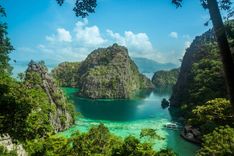Lapuz-Lapuz Beach (Fairways Beach)
Lapuz-Lapuz Beach, also called Fairways Beach, sits on Boracay’s northeastern coast inside the Fairways & Bluewater Resort. It’s a long stretch of sand backed by the island’s only 18-hole golf course, so the surroundings are a mix of manicured fairways and raw coastline. It’s not open to the public in the usual sense, so it stays quiet most of the time.
The beach faces east, so it gets early morning sun and calm water thanks to a reef just offshore. The swimming area is fairly protected, and because access is limited, it never feels too busy. It’s one of the best beaches in Boracay for families or anyone wanting a break from the crowds.
Guests staying at the resort have access to loungers, kayaks, paddleboards, and snorkel gear. Staff can bring food and drinks directly to you on the beach. There are also pools and restaurants close by, all part of the same resort complex. If you’re not staying there, day passes are sometimes available, especially in the low season—but it’s best to ask ahead. See our guide to accommodations in the Philippines.
How to get to Lapuz-Lapuz Beach
If you’re staying at Fairways & Bluewater, there’s a shuttle that runs to the beach. If not, you can ask at the main entrance about day pass availability. From White Beach or D’Mall, a tricycle to the resort entrance costs around PHP 200–300 and takes 15–20 minutes.
When to visit Lapuz-Lapuz Beach
This beach is best in the early morning, between 6–8 AM, when the water is still and the light is nice. Mid-morning through early afternoon is good for swimming. If you’re coming later in the day, it’s quieter and cooler, though you won’t get sunset views from this side of the island.






